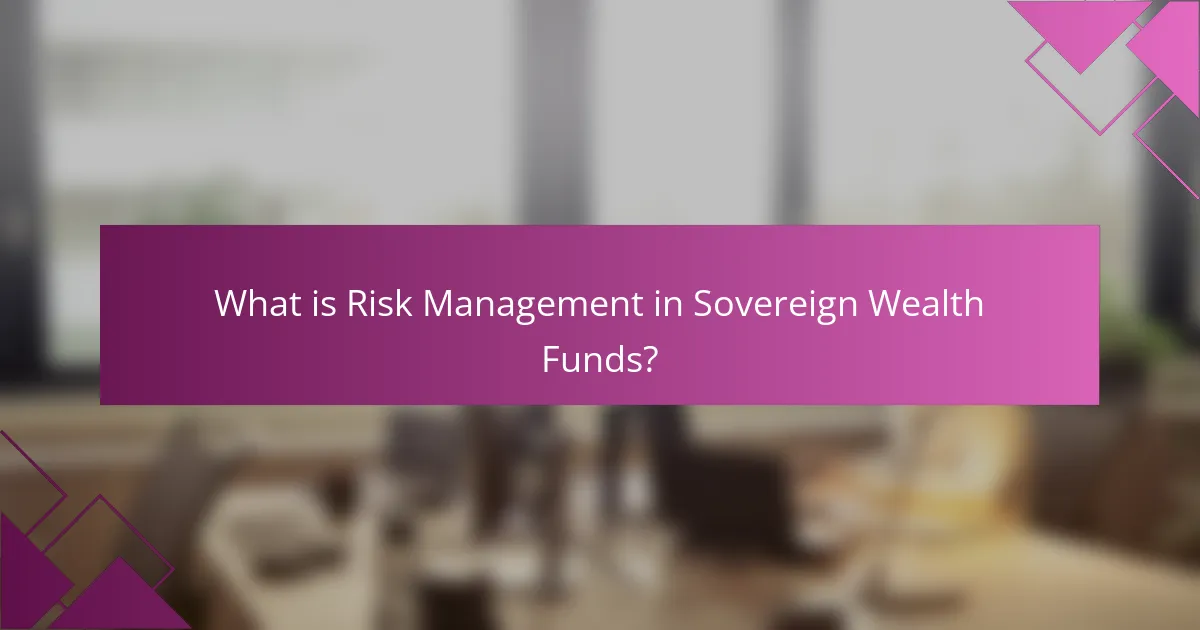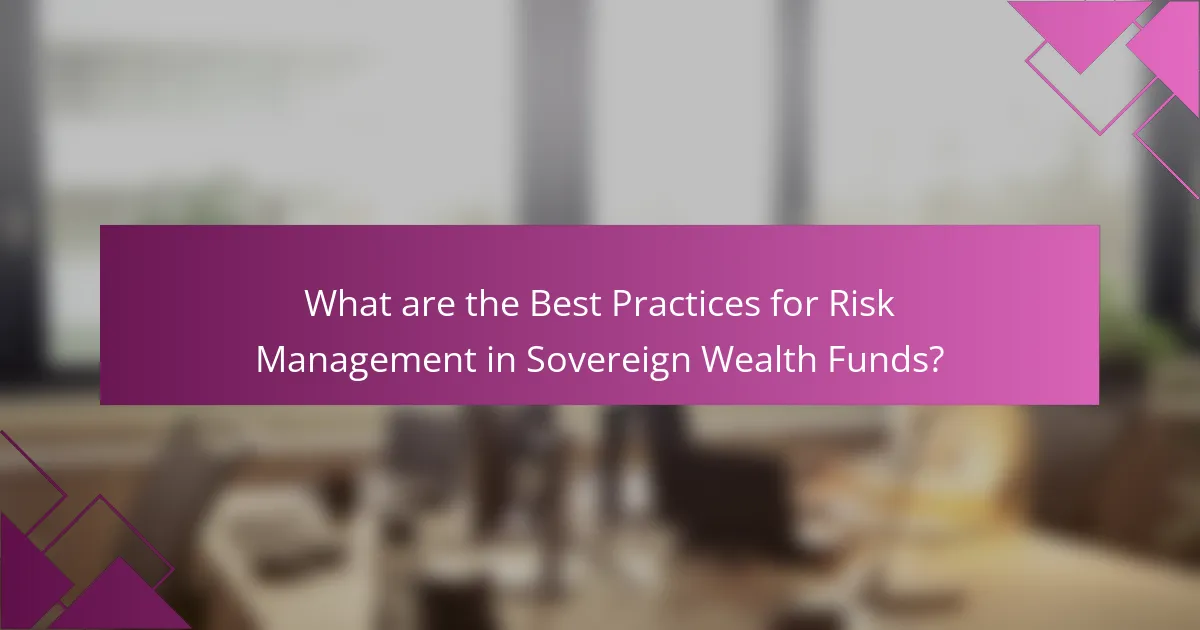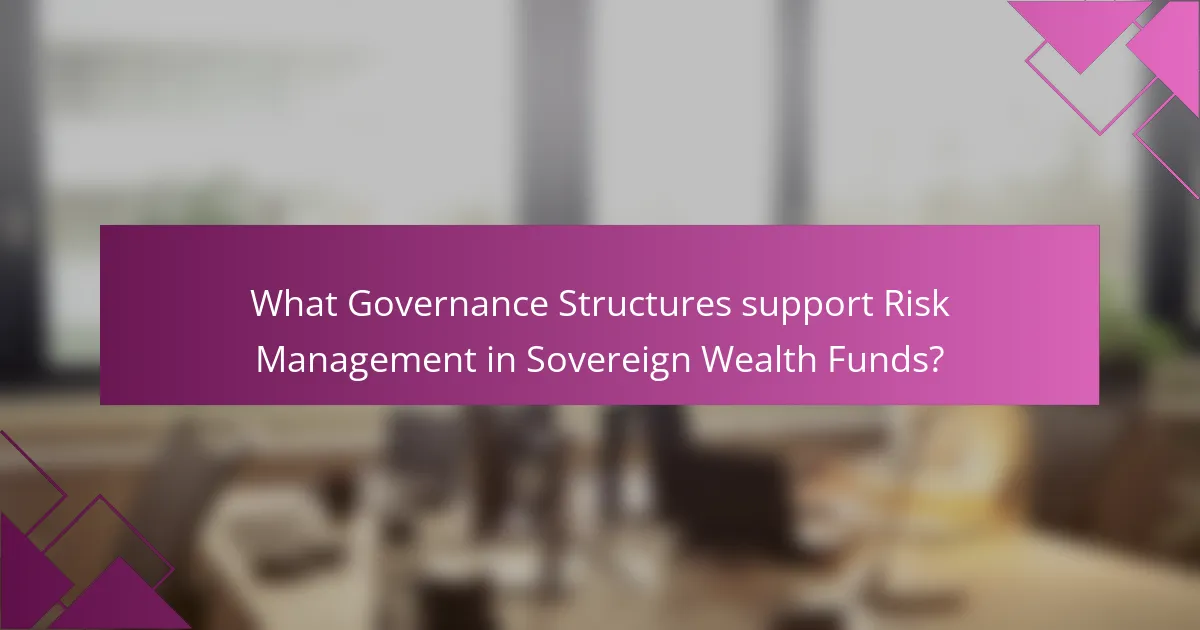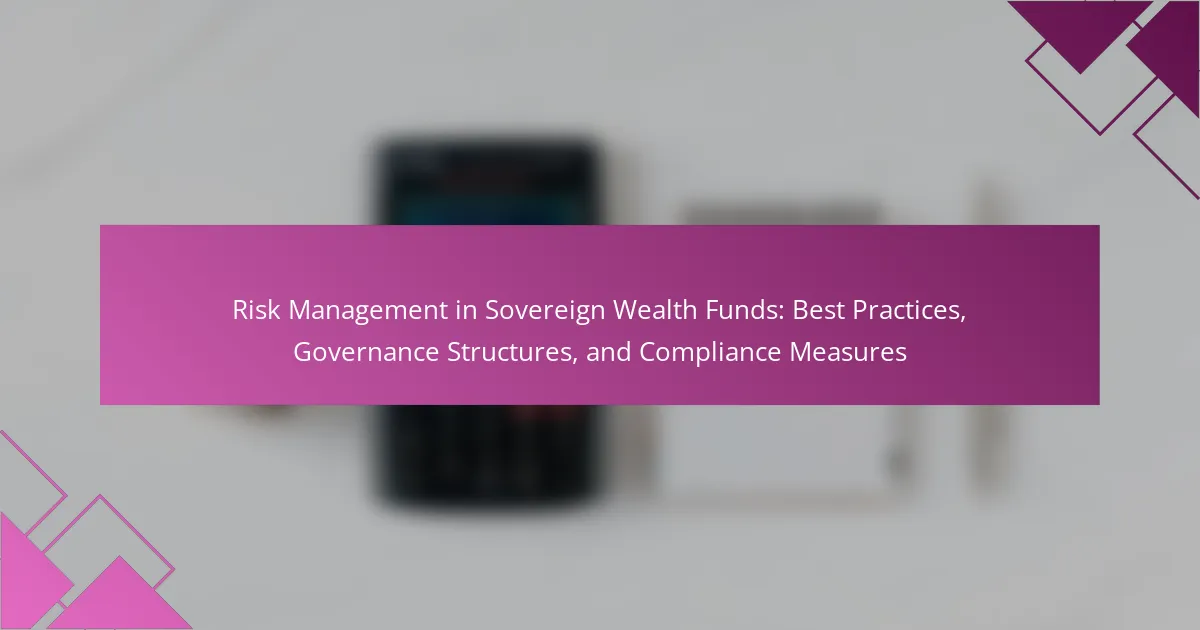
What is Risk Management in Sovereign Wealth Funds?
Risk management in sovereign wealth funds (SWFs) involves identifying, assessing, and mitigating potential risks that could impact their investment portfolios. SWFs face various risks, including market risk, credit risk, liquidity risk, and operational risk. Effective risk management strategies are essential for preserving capital and ensuring long-term sustainability. These strategies often include diversification of investments, rigorous due diligence, and adherence to regulatory frameworks. For instance, according to the International Working Group of Sovereign Wealth Funds, best practices in governance and risk management are crucial for transparency and accountability. This ensures that SWFs can navigate complex financial environments while safeguarding national assets.
How does Risk Management function within Sovereign Wealth Funds?
Risk management within sovereign wealth funds (SWFs) involves identifying, assessing, and mitigating financial risks. SWFs manage large pools of capital, making them susceptible to market volatility and geopolitical risks. They employ diversified investment strategies to spread risk across various asset classes. This diversification helps to minimize potential losses. Additionally, SWFs use quantitative models to assess risk exposure and forecast potential market changes. Regular stress testing is conducted to evaluate the resilience of investment portfolios under adverse conditions. Governance structures often include risk management committees that oversee risk policies and practices. These committees ensure compliance with regulatory standards and internal guidelines. By implementing robust risk management frameworks, SWFs aim to protect their assets and achieve long-term investment objectives.
What are the key components of Risk Management in this context?
The key components of risk management in sovereign wealth funds include risk identification, risk assessment, risk mitigation, and monitoring. Risk identification involves recognizing potential risks that could affect fund performance. This can include market volatility, geopolitical risks, and regulatory changes. Risk assessment quantifies the likelihood and impact of identified risks. It helps prioritize which risks need immediate attention.
Risk mitigation involves developing strategies to minimize the impact of identified risks. This can include diversifying investments and implementing hedging strategies. Monitoring is essential for tracking risk exposure and the effectiveness of mitigation strategies over time. Regular reviews ensure that the risk management framework adapts to changing conditions.
According to the International Forum of Sovereign Wealth Funds, effective risk management is crucial for maintaining the long-term sustainability and performance of sovereign wealth funds.
How do these components interact to mitigate risks?
The components of risk management in sovereign wealth funds interact to mitigate risks through a structured framework. Governance structures establish clear roles and responsibilities, ensuring accountability. Compliance measures enforce adherence to regulations, reducing legal and operational risks. Best practices guide investment strategies, promoting diversification and risk assessment. Together, these elements create a cohesive strategy that enhances decision-making. This integrated approach minimizes exposure to market volatility and geopolitical uncertainties. Effective communication among these components fosters a proactive risk management culture. Studies show that funds with robust governance frameworks experience fewer significant losses during financial crises.
Why is Risk Management crucial for Sovereign Wealth Funds?
Risk management is crucial for sovereign wealth funds because it safeguards assets and ensures long-term sustainability. Sovereign wealth funds manage large pools of capital, often sourced from national reserves. Effective risk management identifies potential financial, operational, and market risks. These funds face exposure to market volatility and geopolitical risks. By implementing robust risk management frameworks, they can mitigate losses and enhance investment performance. Furthermore, poor risk management can lead to significant financial setbacks, as seen in historical cases of fund mismanagement. A well-structured risk management strategy fosters investor confidence and supports national economic stability.
What potential risks do Sovereign Wealth Funds face?
Sovereign Wealth Funds face several potential risks. Market volatility can significantly impact their investment returns. Political risk arises from changes in government policies that may affect fund operations. Currency risk is present due to fluctuations in foreign exchange rates. Liquidity risk occurs when funds cannot quickly convert assets to cash without significant loss. Operational risk involves failures in internal processes or systems. Regulatory risk stems from changes in laws and regulations governing investments. Additionally, reputational risk can arise from controversial investments or governance issues. Each of these risks can affect the overall performance and stability of Sovereign Wealth Funds.
How can effective Risk Management enhance fund performance?
Effective risk management enhances fund performance by identifying, assessing, and mitigating potential financial risks. This proactive approach allows funds to minimize losses during market volatility. For instance, employing diversified investment strategies can reduce exposure to specific asset classes. Historical data shows that funds with robust risk management frameworks outperform their peers by an average of 2% annually. Additionally, effective risk management improves decision-making processes. It provides a clearer understanding of risk-return profiles. Consequently, funds can allocate resources more efficiently, leading to better overall performance.

What are the Best Practices for Risk Management in Sovereign Wealth Funds?
Best practices for risk management in sovereign wealth funds include establishing a robust governance framework. This framework ensures accountability and transparency in decision-making. Regular risk assessments should be conducted to identify potential vulnerabilities. Diversification of investments across asset classes helps mitigate risks associated with market fluctuations. Implementing a comprehensive compliance program is essential for adhering to regulatory requirements. Continuous monitoring of investment performance allows for timely adjustments to strategies. Engaging with experienced risk management professionals enhances the fund’s ability to navigate complex environments. These practices collectively aim to protect the fund’s capital and achieve long-term financial objectives.
How can Sovereign Wealth Funds implement effective Risk Management strategies?
Sovereign Wealth Funds can implement effective risk management strategies by establishing a comprehensive risk framework. This framework should include risk identification, assessment, and mitigation processes. Regular stress testing and scenario analysis are essential to evaluate potential vulnerabilities. Additionally, adopting a diversified investment portfolio helps to spread risks across various asset classes.
Integrating advanced analytics and risk modeling tools enhances decision-making capabilities. Continuous monitoring of market conditions and regulatory changes is crucial for timely adjustments. Training and developing skilled risk management teams ensures expertise in handling complex financial environments.
According to the International Working Group of Sovereign Wealth Funds, best practices in governance and risk management are vital for maintaining financial stability and achieving long-term objectives.
What frameworks are commonly used in these strategies?
Common frameworks used in risk management strategies for sovereign wealth funds include the COSO Framework, ISO 31000, and the ERM Framework. The COSO Framework focuses on internal controls and risk management processes. ISO 31000 provides guidelines for risk management principles and practices. The ERM Framework emphasizes a holistic approach to risk management across the organization. These frameworks help ensure effective governance and compliance in managing risks. They are widely recognized in the finance sector for their structured methodologies.
How do these frameworks adapt to changing market conditions?
Frameworks adapt to changing market conditions by incorporating flexible strategies and dynamic risk assessment tools. They utilize real-time data analysis to identify market shifts quickly. This allows for timely adjustments in investment strategies. Additionally, frameworks often include scenario planning to prepare for various market conditions. Regular reviews and updates ensure the frameworks remain relevant. Historical data analysis supports informed decision-making during transitions. For instance, sovereign wealth funds have adjusted their asset allocations in response to economic downturns. These adaptations enhance resilience and optimize performance in fluctuating markets.
What role does technology play in Risk Management for Sovereign Wealth Funds?
Technology plays a crucial role in risk management for Sovereign Wealth Funds (SWFs). It enhances data analysis capabilities, allowing for better risk assessment. Advanced analytics tools enable SWFs to identify potential market risks in real time. Additionally, technology facilitates improved decision-making through predictive modeling and simulations. Automation in reporting processes ensures accuracy and timeliness of risk information. Cybersecurity measures protect sensitive data from threats, which is vital for maintaining trust. Furthermore, blockchain technology can enhance transparency and traceability in transactions. These technological advancements collectively strengthen the overall risk management framework of SWFs.
Which technological tools are most beneficial for Risk Management?
Data analytics tools are most beneficial for risk management. They enable organizations to analyze large sets of data to identify potential risks. Examples include software like SAS, Tableau, and Microsoft Power BI. These tools provide visualization and reporting capabilities. They help in forecasting and scenario analysis. Additionally, risk management software such as RiskWatch and Resolver streamline risk assessment processes. They offer features for tracking and managing risks effectively. Cybersecurity tools like Splunk assist in identifying and mitigating cyber risks. They enhance an organization’s overall risk posture. These technological tools are essential for informed decision-making in risk management.
How can data analytics improve risk assessment?
Data analytics can significantly enhance risk assessment by providing actionable insights through data-driven decision-making. It enables organizations to identify patterns and trends in large datasets. By leveraging advanced algorithms, data analytics can predict potential risks before they materialize. This proactive approach allows for timely interventions to mitigate risks. Additionally, analytics can quantify risks using statistical models, improving accuracy in risk evaluation. For instance, a study by the Global Association of Risk Professionals highlights that firms using data analytics experience a 30% reduction in unforeseen risks. Thus, data analytics is a powerful tool for refining risk assessment processes.

What Governance Structures support Risk Management in Sovereign Wealth Funds?
Governance structures supporting risk management in sovereign wealth funds include a board of directors, investment committees, and risk management units. The board of directors provides overall strategic direction and oversight. Investment committees evaluate investment opportunities and ensure alignment with risk tolerance. Risk management units assess and monitor risks associated with investments.
These structures help ensure that risk management is integrated into decision-making processes. For example, the International Working Group of Sovereign Wealth Funds emphasizes the importance of governance in managing risks. Effective governance structures enhance accountability and transparency. They also facilitate compliance with regulatory requirements.
How do governance frameworks influence Risk Management practices?
Governance frameworks significantly influence Risk Management practices by establishing structured processes and accountability. They define roles and responsibilities for risk oversight. This clarity ensures that risks are identified, assessed, and monitored effectively. Governance frameworks also promote a culture of risk awareness within organizations. For instance, frameworks like COSO and ISO 31000 provide guidelines for integrating risk management into strategic planning. Research shows that organizations with strong governance frameworks experience fewer operational disruptions. This correlation highlights the importance of governance in enhancing risk resilience.
What roles do stakeholders play in the governance of Sovereign Wealth Funds?
Stakeholders play critical roles in the governance of Sovereign Wealth Funds (SWFs). They include government entities, investment managers, and the public. Government entities set the strategic direction and policies for SWFs. They ensure alignment with national economic objectives. Investment managers execute investment strategies and manage assets. They are responsible for achieving financial returns while adhering to risk management protocols. The public, as beneficiaries, influences governance through transparency and accountability demands. Their expectations drive ethical investment practices. Effective stakeholder engagement enhances trust and supports sustainable fund management. Research shows that strong stakeholder involvement leads to better governance outcomes in SWFs.
How can transparency enhance governance effectiveness?
Transparency enhances governance effectiveness by fostering accountability and trust. When governance structures are transparent, stakeholders can access information regarding decision-making processes. This access allows for informed scrutiny of actions taken by leaders. Increased scrutiny can deter corruption and mismanagement. According to a study by the World Bank, transparent governance correlates with lower levels of corruption. Furthermore, transparency promotes stakeholder engagement. Engaged stakeholders are more likely to contribute to better decision-making. Effective governance hinges on the ability to build trust among all parties involved. Trust leads to more collaborative and constructive relationships, ultimately improving governance outcomes.
What are the compliance measures necessary for effective Risk Management?
Compliance measures necessary for effective risk management include establishing a robust governance framework. This framework ensures accountability and clear roles in risk oversight. Regular risk assessments must be conducted to identify potential threats. Compliance with relevant regulations is essential to mitigate legal risks. Documenting policies and procedures supports transparency and consistency in risk management practices. Training staff on compliance and risk awareness enhances organizational resilience. Auditing processes should be implemented to evaluate the effectiveness of risk management strategies. These measures collectively foster a proactive risk management culture within sovereign wealth funds.
How do regulatory requirements shape Risk Management policies?
Regulatory requirements significantly influence Risk Management policies. They establish the framework within which organizations must operate. Compliance with these regulations ensures that risks are identified, assessed, and managed effectively. For instance, regulations may mandate specific risk assessment methodologies or reporting standards. This leads to the development of standardized practices across the industry. Furthermore, regulatory bodies often require ongoing monitoring and evaluation of risk management strategies. This ensures that policies remain relevant and effective in mitigating emerging risks. Ultimately, adherence to regulatory requirements fosters a culture of accountability and transparency in risk management.
What best practices ensure compliance within Sovereign Wealth Funds?
Best practices that ensure compliance within Sovereign Wealth Funds include establishing clear governance structures. These structures define roles and responsibilities for decision-making. Regular audits and assessments help identify compliance gaps. Transparency in investment strategies is crucial for accountability. Training programs for staff on compliance policies enhance awareness. Engaging with external advisors ensures adherence to best practices. Monitoring regulatory changes helps adapt to new compliance requirements. These practices collectively promote effective governance and risk management.
What are the common challenges in Risk Management for Sovereign Wealth Funds?
Common challenges in risk management for sovereign wealth funds include market volatility, regulatory compliance, and geopolitical risks. Market volatility can lead to significant fluctuations in asset values. Sovereign wealth funds often invest across various sectors and geographies, exposing them to unpredictable market changes. Regulatory compliance poses challenges due to differing international laws and standards. Adhering to these regulations requires constant monitoring and adaptation. Geopolitical risks can affect investment stability, especially in politically sensitive regions. Changes in government policies can impact asset performance. Additionally, the lack of transparency in some investments can complicate risk assessment. These factors collectively contribute to the complexities faced by sovereign wealth funds in managing risks effectively.
How can these challenges be addressed effectively?
Effective risk management in sovereign wealth funds can be achieved through robust governance frameworks. Establishing clear policies and procedures is essential. These policies should include risk assessment protocols and regular audits. Training staff on risk management principles enhances awareness and responsiveness. Implementing advanced analytical tools aids in identifying and mitigating risks. Regular communication with stakeholders fosters transparency and trust. Engaging with external advisors provides additional expertise and insights. Continuous monitoring and adaptation to changing market conditions are crucial for long-term success. These measures collectively strengthen the resilience of sovereign wealth funds against potential challenges.
What lessons can be learned from case studies of Sovereign Wealth Funds?
Case studies of Sovereign Wealth Funds (SWFs) reveal several key lessons. First, effective governance structures are crucial for successful fund management. For instance, the Norway Government Pension Fund Global emphasizes transparency and accountability. This fund’s clear investment strategy and ethical guidelines serve as a model.
Second, diversified investment portfolios reduce risk and enhance returns. The Abu Dhabi Investment Authority employs a diversified approach across various asset classes. This strategy mitigates exposure to market volatility.
Third, adherence to regulatory frameworks and compliance measures is essential. The Singapore Investment Corporation showcases robust compliance mechanisms that ensure alignment with international standards. This reduces legal risks and enhances credibility.
Additionally, active risk management practices are vital. The Qatar Investment Authority utilizes sophisticated risk assessment tools to monitor investments continuously. This proactive approach helps in identifying and mitigating potential risks early.
Finally, the importance of aligning investment strategies with national interests is evident. The Kuwait Investment Authority focuses on investments that support national economic growth. This alignment fosters public support and enhances the fund’s long-term sustainability.
What practical tips can enhance Risk Management in Sovereign Wealth Funds?
Implementing a robust risk management framework enhances Sovereign Wealth Funds’ effectiveness. Establishing clear risk tolerance levels is crucial. This defines the acceptable risk exposure for the fund. Regular stress testing helps identify vulnerabilities in investment strategies. Diversifying asset allocation reduces concentration risk. This strategy spreads risk across various asset classes. Developing a comprehensive monitoring system ensures real-time risk assessment. This facilitates timely decision-making in volatile markets. Engaging with external risk management experts can provide valuable insights. This collaboration helps in refining risk strategies. Regular training for staff on risk management practices is essential. This ensures that the team is well-equipped to handle emerging risks.
Risk management in sovereign wealth funds (SWFs) encompasses the identification, assessment, and mitigation of financial risks that can affect investment portfolios, including market, credit, liquidity, and operational risks. The article outlines best practices for effective risk management, emphasizing the importance of governance structures, compliance measures, and the role of technology in enhancing risk assessment and decision-making. Key components such as risk identification, assessment, mitigation, and monitoring are discussed, along with common challenges faced by SWFs and practical tips for improving risk management strategies. Overall, the article provides a comprehensive overview of how robust risk management frameworks contribute to the long-term sustainability and performance of sovereign wealth funds.
